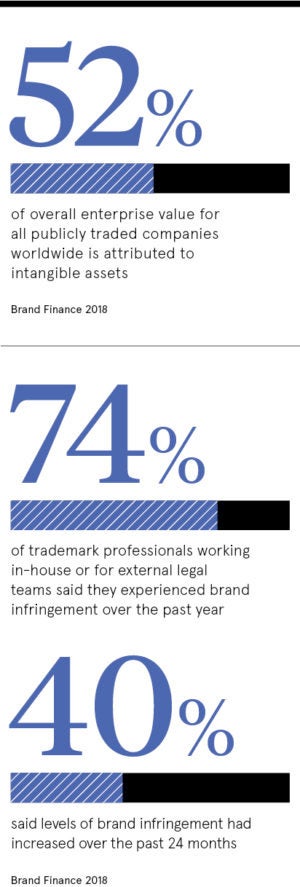Trademarks can encapsulate all a brand represents in a single design or phrase. So how do you ensure you have the right legal cover in a world where firms must continually reinvent themselves to keep consumers engaged?
Take Gillette’s decision last year to update its famous “The best a man can get” slogan to “The best a man can be” to make its shaving products reflect a more modern view of masculinity in the age of #Metoo.
Or the way Channel 4 and Google modify their iconic logos on a regular basis to keep their brands feeling fresh.
“Brand protection and enforcement strategies are designed to create an exclusion zone around the brand to enable the client freedom within that zone to build and develop the brand and do what they want with the brand,” says Lee Curtis, partner at law firm HGF.
“The problem is while the marketers like fluidity, the law likes certainty, so it’s about finding a happy medium.”
The trouble with trademarks? They’re tricky to procure
 Firms considering whether to protect a new mark or logo, or amend an old one, should ask themselves if it is going to be around for a long time as protecting it will come with costs.
Firms considering whether to protect a new mark or logo, or amend an old one, should ask themselves if it is going to be around for a long time as protecting it will come with costs.
And you can only register a trademark if it is inherently distinct or has acquired distinctiveness through use, which makes it much harder to protect a phrase than a logo or brand name, as phrases tend to be more descriptive.
If a firm does want to register a trademark, it must first check no one else has the rights to prevent them using it, although companies often invest time and money in development only to find a mark has already been taken.
“It’s about making a trademark effective commercially; you identify your target customer, then create a trademark that would resonate with them,” says Jerry Bridge-Butler, chartered trademark attorney at Barren Warren Redfern.
“That’s a creative job, but the important thing is the legal view: am I free to use this and can it be protected?”
Protecting their IP can cost brands money and their reputation
The next, and perhaps harder, job is ensuring your rights are protected and any potential threats are headed off. Take the way many Premier League football clubs have changed their logos in recent years to increase IP protection, thereby bulwarking lucrative merchandise sales.
“Words like yo-yo and sellotape were trademarks once, but they became generic in various countries and the trademark holder lost their corresponding registered rights,” says Kathy Berry, an intellectual property (IP) lawyer at Linklaters.
“And if an infringer takes your marks, but makes lower-quality products or has reputational issues, it can affect your brand.”
You may have no choice but to take action against potential infringers, however it’s worth remembering that a heavy-handed approach to enforcement can undermine your brand strategy.
Mr Curtis gives the example of supermarkets, which are often accused of making products that look similar to branded goods. The risk for those brands is that if they supply a supermarket and then they sue them, they may put their own businesses in jeopardy.
“Commercial reality comes into play and the supermarkets are experts at sailing close to the wind in terms of what is allowed,” he says.
There’s more to a great brand strategy than trademarks
Firms must also think about what enforcement might mean for their public image. For example, if a big company takes action against a smaller one that infringes its IP, it may end up looking nasty in the eyes of its customers, and in the age of social media that can quickly turn into a backlash.
“If a big consumer brand name tries to stop a small local company using a name, that small company can immediately go on social media and say it’s ridiculous. Due to the fame of the big brand, the media can pick up the story,” says Mr Bridge-Butler.
“Legally there probably is a case, but to the public at large it can look silly, as most people would say they wouldn’t confuse the two names.”
The problem is while the marketers like fluidity, the law likes certainty, so it’s about finding a happy medium
The key, Ms Berry says, is to be strategic, keeping protection at the core of your brand strategy and taking action when necessary. The risk comes from underestimating the importance of protecting and defending your trademarks, something smaller companies are often guilty of partly because they lack in-house legal teams. “It usually ends up being a false economy,” she says.
Mr Bridge-Butler points out that despite the challenges of protecting IP, companies can take cheer from the fact copying rarely leads to mass commercial success.
“Branding is the most important thing a business has and, if you get it right, it will maximise your growth,” he says.
“But who would fall in love with a clothing brand that tried to protect a phrase which really has nothing to do with it? Or if you rip off something and tweak it slightly, is that really branding at the highest level?”
The trouble with trademarks? They're tricky to procure

